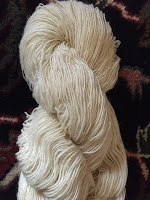 |
| Pinelands Spring cowl Yarn: single ply handspun Merino |
I have a basket full of handspun. Now what?
Last year, I had bags of roving piled in my studio. This year, the bags had been transformed into yarn. I am pretty much happy with the yarn, but the more I spun, the more satisfied I became.Over the years, I have spent far too much time dwelling on my frustration in spinning larger gauge yarns. As I was sharing this with other spinners, the reality hit me: I prefer to work with finer gauge yarns. Why do I need to spin larger gauge yarn? I don't.
 |
| Yarn being wound from the bobbin |
So after freeing myself from 'should do's,' I have moved on to focus on spinning fine to medium yarns for consistency. Should I get bored, I can add any number of challenges by spinning wool from different breeds.
Consider the breed
Winter's Past Farm raises Coopworth sheep and I can't say enough good things about spinning their fleece. At the top of the list is 'easy to spin.' I also like the color, which accepts dye easily. I had some Tunis and found spinning that about the same as the Coopworth. Then I moved on to the Dorset, a down wool, and Merino, a fine wool, both with shorter staple lengths.Then Romney, which I was gifted at the local guild's Rock Day celebration. Easy to spin but for one major negative totally attributable to the shearer. It was riddled with second cuts--short lengths of wool from the shearer's second pass on the sheep. The short fibers form noils, which defeat smooth, even yarns and are the very devil to pick out when spinning.
 |
| Counting as I wind on |
This year's focus was on spinning singles suitable for knitting. That meant taming the twist as much as possible. With this goal, I've been spinning these with a short draw with my wheel ratio set as slow as possible.
My first project through to completion was Pinelands Spring cowl knit with Merino singles on a knitting machine. The pattern itself adds an exaggerated stitch in the rib variation, which in itself adds texture but doesn't draw attention to any inconsistencies in the yarn. (If you like the pattern, it's available as a free download on Ravelry.)
Spinning data
 |
| Skein of Romney singles |
I keep a record of my yarn that includes:
- Date finished
- Weight of the skein
- Length of the yarn in the skein
- Wraps per inch (wii)
- Technique: Long draw, short draw, etc.
- Final product: Singles, plied, etc.
As you can see in the skein at right, there is still some twist. For the cowl, I soaked the skein of Merino singles and hung it to dry with some weight on the bottom of the skein. The cowl has no discernible twist--none that I can tell anyway.
The Romney singles skein is absolutely beautiful!
ReplyDeleteThank you. Given your skill, I am particularly grateful for the compliment.
ReplyDelete